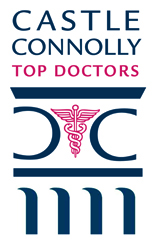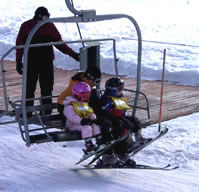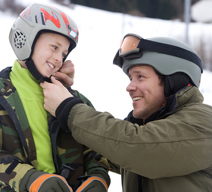|
Skiing and Snowboarding
Both downhill skiing and snowboarding are very popular winter
sports, even for people who live at low elevations. While there are a
number of similarities, these two sports have some important
differences. Neither is better than the other, although both skiers and
boarders will claim their sport is best. It is largely a matter of
personal preference and, to some extent, perhaps a matter of body type
or existing orthopedic conditions.
Skiers control their skis by shifting weight from one ski to another
to execute turns and to control their downhill direction. Because
snowboarders' feet are anchored to one large snowboard and pointing in
the same direction, they must use their upper bodies to control their
downhill movement. Skiers use poles to assist with turns and to help
maintain balance, while boarders are only able to use their arms and
hands for balance.
Some resorts permit skiers and snowboarders to be on the same chair
lifts and on the runs or trails. Others will restrict certain areas of
the mountain to only skiers or to only snowboarders. Occasionally, you
will find an entire ski resort area dedicated to skiing only. In
planning your ski vacation, you should check on what will be permitted
at the resorts you are considering, in case it would make a difference
in your vacation destination.
Skiing and snowboarding are not sports where you can ski or snowboard yourself into "good shape". Instead, you must be in very good physical condition
before going onto the mountain to ski or to board. Otherwise, you are
taking too great a risk of getting hurt. It is important to start
training at least three months prior to your ski vacation. If you are
living and training near sea level, you definitely cannot "short cut"
the time you will need to get ready for mountain sports.
PREPARING FOR YOUR SKI TRIP (3 months in advance):
Skiing and
snowboarding require good coordination between your lower body, which
absorbs the impact, and your upper body, which handles the turning,
balance, and poling. This takes a lot of energy, and can burn somewhere
between 1,500 and about 3,000 calories a day. You obviously need to be
in good shape to handle that level of physical active at a high
altitude, especially when you live close to sea level.
Your knees, thighs, hips, abdomen, back, and, to some extent, arms
have big physical demands placed on them in skiing or snowboarding.
Your training program needs to emphasize both strength training and
flexibility for all of these muscle groups, as well as your overall
balance, agility, and aerobic conditioning.
The stronger
your muscles are, especially your thigh muscles, the easier it will be
to ski and snowboard without getting too tired too fast. In skiing, the
knees are slightly bent with a nearly constant up and down motion,
while managing balance. As a result, the quadriceps can become fatigued
quickly if not in great shape. Cycling is one good way to prepare for
your ski trip. Working out on the stairs or on a stair master is also
beneficial. If you are a skilled in-line skater, you will find that
sport to be helpful, in that in-line skating involves the same muscles
groups in similar ways.
For your abdominal and back muscles, work on your core conditioning exercises.
Weight training is beneficial. Concentrate on both your quadriceps and
hamstring muscles, but don't forget your arms. You will need strength
in your arms pushing against your ski pole to get upright again from
some falls. Without that arm strength, you will have to remove your
skis to stand up and then have to put the skis back on again, which
might be a little difficult to do on some slopes.
Skiing and snowboarding are also very aerobically demanding. Living at
low elevations and travelling to the much higher elevations of the
resorts will naturally challenge your body's demand for oxygen even
before you do any exercise. Making sure you are aerobically fit before
you go on your ski trip is therefore extremely important. Running,
swimming, stair training, or a step aerobic program are all great
choices.
Good flexibility of the various joints actually helps reduce the
chances of injury when you fall, especially tendon and ligament
injuries. Don't try to convince yourself you will never fall. Even the
most experienced skiers and boarders will fall occasionally.
Ski resorts will have children's ski school for children 4 years and
older with a schedule similar to your children's regular school hours.
Many resorts will also have a child care facility for children ages 2
and 3, where they play indoors most of the time and go outside for
short periods to begin experiencing "baby skiing" and playing in the
snow. Help your children prepare for skiing by doing "froggy hops."
Turn it into a family affair, and do froggy hops together. (If you are
planning to snowboard, you will be doing "froggy hops" yourself up on
the mountain with your board.)
TEN RULES TO HELP AVOID INJURY ON THE SLOPE:
1.) ALWAYS WEAR
YOUR HELMET: It doesn't matter how old you are. It is very important to
protect your brain in a fall. And everyone falls sometimes, frequently
with substantial velocity. In fact, the better you are, the harder your
fall is likely to be. Your helmet should be a skier's or snowboarder's
helmet, not some other kind of helmet designed for any other sport.
Helmets are certified to meet the specific requirements of that sport
only.
2.) DON'T USE BORROWED EQUIPMENT: The type of equipment and the binding
settings must be appropriate for you, based upon your height and
weight, as well as your general fitness and your specific skill levels.
If the equipment is not appropriate for you personally, you will be
increasing your risk of injury. Always rent your equipment from a
professional store at the mountain. That way, you can easily make
adjustments if something about your equipment isn't exactly right for
you. Some people are happy with rented boots, and others choose to own
boots which are comfortable for them. If you find a pair of boots you
really like and you know you will be skiing for years to come, it is
reasonable to consider purchasing them. Unless you live very close to a
ski slope, always rent children's equipment. They will outgrow them
before getting a second chance to use them. Just having to buy new
children's ski clothes every year is expensive enough.
3.) FRIENDS ARE BAD TEACHERS. Friends will quickly get bored with
your beginning ski level and will end up taking you to runs they like
to do, where you absolutely do not belong. Unless you are an
experienced skier, start your first day or so with lessons. If you have
never skied or snowboarded before, only go into the mountain with a
certified instructor. Children should be enrolled in ski school as part
of their vacation. Your children will be less apt to develop bad
habits, and they will enjoy learning with other children of similar
skill.
4.) TAKE IT EASY THE FIRST DAY: Give yourself a
chance to adjust to the altitude and to get your ski or board skills
back again for the season. So many people get hurt on the first day
because their brains remember how good they were last year, but their
bodies have forgotten.
5.) TAKE A RECOVERY DAY: Just as with any other sport, your body needs
a chance to recover after a couple of days of demanding physical
activity. Plan two days of skiing or boarding, and then take a day off
to tour the sites or just to read a book. After a recovery day, you
will do much better on the mountain on that 4th day of your trip. And
you will be less likely to get hurt because your muscles have had a
chance to rest.
6.) DO NOT SKI OR SNOWBOARD ALONE. Always ski with a partner or in a
small group. When you are with others of your similar skill level, you
will be less likely to do something the group knows is "dumb." And if
someone should get hurt, it makes it easier to get help. If you are
alone, check with the resort. Most will have group or mountain guides
who can take small groups all over the mountain, and sometimes to
wonderful places where regular skiers are not permitted.
7.) STAY ON THE MARKED TRAILS: Do not go beyond the "out of bounds"
markers. Either the resort management or the ski patrol put them there
for a reason, even if it isn't obvious to you as to why. To go beyond
these markers means risking serious injury or perhaps even death. Even
though skiing through the trees is fun, understand that trees are
hazards on ski slopes. Too many deaths are due to skiers or boarders
running into trees, and not necessarily at high rates of speed.
8.) DON'T DRINK AND SKI OR SNOWBOARD: Save your alcohol consumption
until you have put your equipment up for the day. Besides affecting
your reflexes and judgment, alcohol is a diuretic and will cause you to
get dehydrated faster. Drink plenty of water during the day on the
mountain.
9.) WATCH FOR ICY CONDITIONS: Skiing or boarding on runs which have
become too icy requires special skill and often special equipment. Icy
conditions will start to show up in areas which are being heavily
skied, in the shadows, and in weather conditions where the surface
warms under the sun and refreezes in the colder night air.
10.) QUIT BEFORE "THE LAST RUN": As soon as you think "I'm going to do
just one more run," it is time to quit NOW. Don't let the group talk
you into doing any more runs after that point. You are tired, and that
last run is when experienced skiers and boarders are most likely to get
hurt.
COMMON INJURIES:
Training on how to fall and how to get back
up will be included in your early ski or snowboard lessons. If you see
a fall coming and have time to react, try to "relax, tuck, and roll."
Once you are down, stay down until you come to a stop. If you try to
stand up while you are still sliding, you are increasing your chances
of hurting your knee, probably your ACL.
Because of the differences between the two sports, skiers are more
likely to injure their legs, especially their knees, whereas
snowboarders are more likely to injure their wrists, elbows, and
shoulders. In fact, snowboarders should wear wrist and elbow guards to
help protect them from serious injury in a fall. Both sports can result
in hitting ones head in a fall, which is why both need helmets for
protection.
Be especially careful when loading onto and off of the lift chair.
If you have a choice, try to sit on one end or the other of the chair
lift, rather than in the middle. This will mean you only have to be
concerned with one other person disembarking with you rather than with
two, with you sandwiched in the middle. Unless you are highly skilled
as a skier, it is best to not mix skiers and boarders on the same chair
because of the differences in how the two must unload when the chair
reaches the top of the lift.
It is rare that an injury would require surgery immediately by
someone you do not know and who will not be able to follow you once you
get home for your post-op care. The few exceptions are serious cuts,
head injuries, and open fractures, which must be treated immediately.
Fortunately, most injuries can be splinted until you get home. By then,
the swelling will be down, and your personal orthopedic surgeon will be
able to manage your entire course of treatment and rehabilitation.
Many of my patients keep my phone number with them on ski trips. If
they have a problem, they can call me directly to ask a question or, if
necessary, to coordinate care between the Emergency Room physician and
myself.
If you have a fall where you hit your head or you can't remember the
fall, it is important to go to the local hospital as soon as possible
to be checked for a potential concussion with late onset. The brain
might be swelling slowly without you realizing it until it is too late.
HIGH ALTITUDE OR ACUTE MOUNTAIN SICKNESS:
The cause of acute
mountain sickness or high altitude sickness is oxygen -- the lack of
it. We have plenty of oxygen in our sea level air, but definitely
not so much in the higher elevations. Some people will adjust to
the altitude faster than others; but even the best of athletes who
train at lower elevations need time to let their bodies adjust before
putting great demands on their lungs in the mountains.
Symptoms of acute mountain sickness will probably show up during the
first 8 to 40 hours. During this time, drink plenty of water, and
avoid alcohol, which can cause dehydration. Also avoid both sleeping
pills and narcotics as these can affect breathing.
Pay close attention to the warning signs. Headache, tingling
around the mouth, nausea, vomiting, dizziness, or unusual fatigue
should not be ignored. The same is true for people with high
blood pressure. If you cannot get the problem resolved pretty
rapidly with over-the-counter medications, go to the nearest emergency
room. Mountain sickness can become fatal if not treated in time.
Your doctor can give you a prescription for Diamox (acetazolamide)
before you go. It won't necessarily prevent mountain or altitude
sickness, but it might help the symptoms. One drawback is that it
can also make some foods or drinks taste very metallic.
DRESS IN LAYERS:
The best way to protect yourself in the
winter weather is to dress in three layers. The first layer is the base
layer or long underwear layer. This layer needs to fit close to the
skin and be able to wick away moisture. The next layer is the middle or
insulation layer. This clothing is often made of fleece or wool. The
outer layer is the ski suit layer, which blocks wind and rain. This is
often of a water-resistent material such as Gore-Tex.
SPRING BREAK SKIING AND SNOWBOARDING:
Serious skiers and
boarders who live near the mountains enjoy Spring skiing. The air is
warmer and the skys are generally a beautiful blue. But Spring skiing
has its own potential dangers. Your skin is more likely to get
sunburned, so apply a sun screen to any exposed skin. The sun is extra
bright reflecting off of the snow, so always protect your eyes from the
sun's damaging rays with goggles or protective sunglasses.
Dress in layers so you can remove or add clothing as needed for
fluctuating temperatures during the day. Still wear your helmet, no
matter how "nice" the weather is. A good helmet will have vents you can
open and close to control air flow when your head is getting too hot or
too cold.
The majority of Spring skiing injuries occur on groomed runs and
lifts which have turned to “corn”, or slush and which can catch the
edge of the ski or unexpectly affect the movement of the board.
Sometimes, the corn or slush will refreeze, turning the surface to a
sheet of ice. Spring skiing conditions are not good conditions to try
to ski fast or to try to do jumps. Falling in Spring ski conditions can
be very different than falling on Winter's powder.
As the snow is beginning to melt, dirt, rocks, and tree stumps start
to be exposed. You must watch for these and try to avoid them. You are
likely to fall, and fall hard, when you hit these hazards, and if you
don't, you definitely can damage the bottom of your skis or your board.
AVALANCHE CONTROL:
Officials will keep careful watch on snow
conditions in ski resort areas. It is common to hear avalanche cannons
being fired to bring down small accumulations of snow on nearby
mountains to remove them before they become dangerous. This is just one
more of several reasons to remain inside the marked resort areas.
— Tom Parr, M.D. |
|
COMMON SPORTS INJURIES & SAFE PARTICIPATION
Baseball & Softball
Basketball
Bicycling
Boating & Waterskiing
Cheerleading & Gymnastics
Dance
Fishing
Football
Golf
Horseback Riding
Ice Skating & Hockey
Martial Arts
Personal Conditioning
Running & Jogging
Skateboarding & Rollerblading
Skiing & Snowboarding
Soccer
Swimming
Tennis
Track & Field
Volleyball

SPORTS MEDICINE RECOGNITION

Recognized as one of the "Top Sports Medicine Orthopedic Surgeons in the USA" by Castle Connolly.
Dr. Parr has been named as an "Outstanding Orthopedic Surgeon of Texas", as seen in SPORTS ILLUSTRATED.

SPEAKER'S PROGRAM:
Dr.
Parr enjoys teaching parents and coaches on the various aspects of
sports safety. If you would like him to speak to your group, please
call us.


free Wi-Fi
for our patients
in our office

Follow us on Facebook

Mapquest

Medical Advice Disclaimer

|
|





